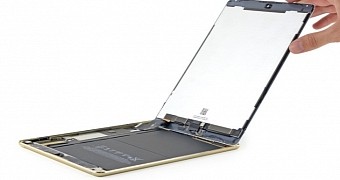A teardown of the iPad Air 2 has found that Apple profits immensely from the storage chips used in the tablet, but overall the profit margins are actually lower than last year.
Using many of the same components found in the original iPad Air, Apple has a nearly-identical bill of materials (BOM) in the iPad Air 2 this year.
How much Apple pays for the components
A report from IHS indicates that the base model of the iPad Air 2, which sells for $499 in the US and €489 in the EU, costs just $275 (€215) to build, “exactly one dollar higher than the previous base model,” according to a statement supplied by IHS analyst Andrew Rassweiler to Re/code.
As for the high-end model with LTE connectivity and 128GB of storage, it sells for $829 in the US and €809 in Europe and costs just $358 / €281 to manufacture. The discrepancy mainly comes from profitable use of flash storage, which Apple buys for mere cents per gigabyte but sells at hundreds of extra dollars / euros in retail prices.
For example, the company spends roughly $60 (€47) extra for the 128GB model, “but charges $300 [€235] more at retail for the higher memory,” reads the report. “Apple reaps a pretty good profit for all that memory,” Rassweiler adds.
That being said, “Apple’s implied profit margin on the iPad Air 2 has dropped slightly to a range of 45 percent to 57 percent depending on the device, compared with the original at 45 percent to 61 percent,” IHS estimates.
“Overall what we’re seeing is a series of refinements from iPad Air 1, nothing earth-shattering at all. But that’s par for Apple’s course,” notes Rassweiler.
Apple also pays less for the display used in this year’s iPad. Previously, this display used to cost Apple $90 / €70, but now the company spends only $77, or about €60 for one. The display unit accounts for 28 percent of the tablet’s entire bill of materials.
We may never know what Apple really pays to make iDevices
While IHS offers a pretty good estimate of how much the Cupertino giant spends on components to create iDevices, the reality is that no one except Apple can ever fully assess the bottom line when it comes to the costs associated with developing, building, marketing, and shipping these devices.
For example, IHS will never have access to the numbers associated with Apple’s costs for research and development.

 14 DAY TRIAL //
14 DAY TRIAL //